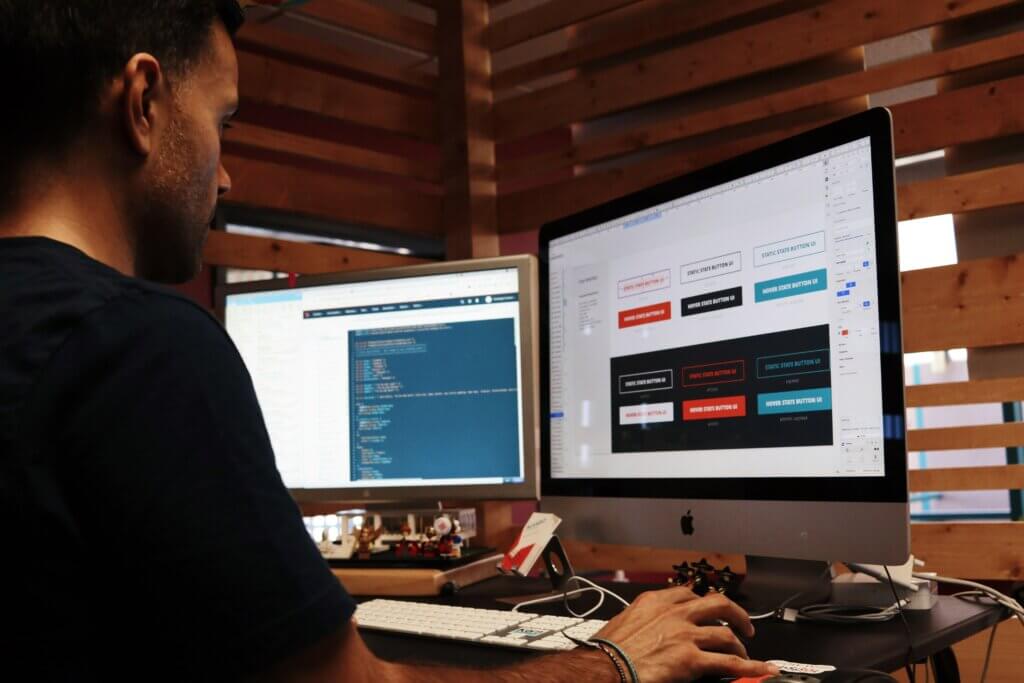What is a Web Designer?
Web Designers develop and build websites and web pages by mixing various visual design components such as text, images, graphics, animations, and videos. A Web Designer might construct a whole new website or simply tweak the style and layout of current pages.
Web Designers are mainly not responsible for understanding how the coding that drives their designs works — rather, their focus is on producing aesthetically acceptable designs and ensuring that consumers have a great user experience when visiting the website.
Web Designers may use computer languages such as HTML, CSS, and JavaScript, as well as graphic design applications such as Adobe Photoshop, Illustrator, and GIMP to create eye-catching designs, and they will test their designs by building prototypes and wireframes. Web Designers have a direct influence on a user’s view of the site and the company. Your work as a Web Designer may have a direct influence on a company’s reputation. As a result, businesses are placing a greater focus on website design, which is mirrored in the growing employment market.
Responsibilities
Though specific tasks for Web Designers will vary depending on the employer and type of work, most responsibilities will include the following:
- Developing unique website concepts for and with clients
- Creating appealing and responsive website landing pages
- Integrating client CMS applications and data feeds into websites
- Optimising sites for optimal performance and scalability
- Using industry and design best practices throughout the website development process
- Testing and upgrading the website design to achieve the greatest possible user experience
- Creating visual images for websites and ensuring that it is consistent with client branding
- Establishing design principles, standards, and best practices, maybe in the form of a style guide document
- Liaising with Back-End Developers or a Web Development Team to guarantee effective integration of web and app logic
- Incorporating website capabilities and features
- Creating sample pages with colours and fonts
- Ensuring website function and stability across platforms (desktop, mobile, tablet)
- Collaborating with marketing and research teams to include brand features and important market research results on the website.
- Communicating design concepts through user flows, process flows, site maps, prototypes, and wireframes.
- Providing internal and external customer service throughout the website’s development and launch.
- Creating design concepts and presenting the website’s structure
Salary
The salary for a Web Designer is influenced by their employer, experience and geographic location
The projected UK salary for a Web Designer is £29,997 per year, with an average income of £27,614 per year. Salaries range from £18,000 to £58,000. The additional compensation is anticipated to be £2,384 per year. This may include a monetary incentive, a commission, gratuities, and profit sharing. The estimated London salary for a Web Designer is £35,513 per year, with an average salary of £33,802 per year. Salaries range from £19,000 to £68,000. The estimated additional pay is £1,711 per year.
Working hours and work location
As a Web Designer you will usually work Monday through Friday, 9 a.m. to 5 p.m., you may need to work extra hours in the evenings or on weekends to meet deadlines. Some occupations may need you to be on-call at all hours of the day or night to deal with unanticipated situations. To operate as a Web Designer, you simply need a computer, software, and high-speed internet so you can work from practically anywhere. This type of work is ideal for freelance work, being self-employed, and working from home.
What to expect
If you want to be a Web Designer, you’ll need to understand what goes on a daily basis.
Web Designers interact with customers to determine their needs and services, create comprehensive specifications, and develop sample layouts for them. This position’s daily activities include designing graphics, animations, and pages, as well as presenting preliminary ideas to clients. Working with various content management programmes, coding, altering digital photos, registering online domain names, and organising the site’s host are other responsibilities.
If you’re thinking about ways to become a good Web Designer, you should know that it takes much more than being tech-savvy or having a passion for websites. To get a high ranking for the website and individual pages, you’ll need to grasp legal regulations such as accessibility requirements, privacy, and freedom of information, as well as apply SEO (search engine optimization). Web Designers ensure that all visual material adheres to the organisation’s logo and standards, and they proofread the text before it is uploaded.
Debugging code, changing text, and redesigning websites are all common responsibilities, as are interacting with other agencies. A Web Designer is in charge of completing the brief by the deadline, delivering the finished product, and providing technical assistance thereafter. You might also collaborate with Graphic Designers and Web Developers.
Qualifications
Web Designers come from a variety of educational and professional backgrounds, with many beginning their careers in web development, graphic design, or other industry connected to visual design. To get into Web Design, you don’t necessarily need a bachelor’s degree. Although having a bachelor’s degree or a master’s degree in a field like Information Technologies, design, communications or Marketing couldn’t hurt, a traditional four-year college degree is unlikely to give you the skills you would need to be employable as in Web Designer.

Skills
must have skills:
In order to be successful as a Web Designer you will need to acquire or possess the following skills:
- Communication skills- A designer must be able to speak with a firm about what they want, ask questions about the intended audience, and communicate their ideas for a successful website. Companies seek a responsive designer in addition to someone who can communicate. A responsive designer keeps the company informed, clarifies concerns as they emerge, and talks about deadlines.
- Time management skills- As a Web Designer, you may choose to work as a freelancer for several firms at once, or you may choose to work for a single company. To keep many projects going, you’ll need to be able to manage your time efficiently.
- Collaboration skills- A Web Designer frequently collaborates with other individuals to construct a site. A copywriter, graphic designer, or even personnel of an IT department may be involved in the building of a website. If this is the case, you must be able to listen, collaborate, and accept constructive criticism.
- Visual design skills- A Web Designer’s primary responsibility is to generate visual aspects for a site, therefore understanding design principles is essential. Visual design combines a number of best design standards, such as dimensions, symmetry, typography, and colour schemes.
- Knowledge of User Experience (UX)- The user experience, or UX, explains how a person feels when browsing a website. The goal of a designer is to produce a layout that is both easy to navigate and visually appealing, resulting in a favourable consumer experience. A designer typically examines the audience and studies activities made on the site to construct a website experience that meets a brand’s target market to provide the proper experience for the audience.
- Knowledge of Design Programmes- Web Designers must be skilled in design software such as Adobe Creative Cloud, CorelDraw Graphics Suite, or Inkscape. These tools are frequently used to generate graphic components, mock-ups, and alter photos, which are all required in Web Design.
- Some coding knowledge- A designer does not write the code that allows a site to run, but knowing a little HyperText Markup Language (HTML) or Cascading Style Sheets (CSS) can help you make minor changes to a site. With a rudimentary grasp, you’ll be able to change templates, improve typefaces, and adjust item placements more easily.
Work experience
Alongside the correct abilities and educational background, building an outstanding online portfolio is part of landing a Web Designer job.
In order to stand out and have the opportunity to land the best-paid jobs in the Web Design industry, you should bear in mind the following guidelines to make your portfolio stand out.
- Quality over quantity: Your portfolio should include your greatest work, but you should be selective. It is preferable to highlight fewer, higher-quality sites rather than many sites that do not exhibit your greatest work.
- Regularly update your portfolio: It’s a good idea to set aside time once a quarter to refresh your portfolio. Even if you aren’t producing new work, you may have more context to add or modifications to make depending on your ongoing learnings and goals. It’s far simpler to update things when they’re fresh in your memory than months or years afterwards.
- Emphasise the type of work you desire to do: Is there a certain industry you’d like to work in? Do you wish to concentrate on constructing online stores rather than single-page websites for small businesses? Your portfolio should include the type of work you wish to accomplish as well as samples of work you’re proud of.
- Provide context: Your portfolio is a visual depiction of your greatest work, but it’s also a chance to talk about your influence and initiatives. Consider including a brief three-to-four sentence summary of the site’s goal, problems, and inclusion in your portfolio.
In addition to creating the perfect portfolio, most people who are looking into the career of a Web Designer have discovered new ways to hone their talents. Many people chose to attend coding boot camps, certification courses, or other online Web Design courses to get practical and technical abilities. Web development training or courses teach students how to code in various programming languages, whereas user experience (UX) design courses would undoubtedly be relevant to developing the skill set of aspiring Web Designers or Developers, as UX design principles are dictating the design of every website or web page being created right now.
This will also demonstrate to companies that you are committed to lifelong learning. The British Interactive Media Association (BIMA) delivers digital industry information. Members of BIMA can offer their freelancing services on the website for potential clients to pursue.
Career prospects
The first several years of a Web Design career are spent establishing skills, learning programmes, and completing client briefs. After four to five years, you may be promoted to senior designer. Following further experience, you may discover specific areas that you love the most or where your skills lie, and you may move into other jobs that fill these for major projects. Senior jobs handle clients, oversee project teams, and you could potentially become a corporate director after several years of experience.
If the artistic aspect of Web Design appeals to you, you can specialise in user interface design, graphics, interactive design, information architecture, or front-end web programming. Other alternatives involve the technical aspect, including coding and building a speciality in these. If setting up a firm is more appropriate, you may set up an agency and manage a team yourself. Some Web Designers decide to pursue teaching professions and get a teaching certificate in order to instruct students in higher or further education.
Related Courses
The University of the West of Scotland teaches this program at their London Campus, so you’ll be studying at the heart of the UK’s VFX industry. This one-year, full-time curriculum is for students who have no prior expertise with computers or information technology. The course will help you learn much-needed IT expertise to help you prepare for a job as a Web Designer.
The MBA and digital marketing components are combined in this one-year full-time program at the University of the West of Scotland’s London Campus. The MBA portion of the course looks at business practices and operations such as accounting, finance, and human resources, as well as how they are all related. This course allows students to specialise in digital marketing in a more specific manner.





